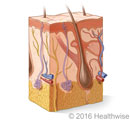Raynaud’s Phenomenon
Topic Overview

What is Raynaud’s phenomenon?
Raynaud’s (say “ray-NOHZ”) phenomenon occurs when the blood vessels in the hands and feet overreact to cold temperatures. The blood vessels are extra sensitive and become more narrow than normal, making the hands and feet feel very cold and numb for a short time.
You may also hear this condition called Raynaud’s syndrome or Raynaud’s disease.
For most people, Raynaud’s is more of a nuisance than a disability.
What causes Raynaud’s phenomenon?
Often Raynaud’s has no known cause. (This is sometimes called primary Raynaud’s.)
Raynaud’s may be a symptom of another disease, such as lupus, scleroderma, rheumatoid arthritis, or atherosclerosis. It may also be caused by taking certain medicines, using vibrating power tools for several years, smoking, or having frostbite. (This is sometimes called secondary Raynaud’s.)
Certain things can trigger an attack of symptoms. The most common trigger is exposure to cold. In the cold, it’s normal for the body to narrow the small blood vessels to the skin and to open the blood vessels to the inside parts of the body to keep the body warm. But with Raynaud’s, the body restricts blood flow to the skin more than it needs to. Other triggers can include emotional stress and things that affect the flow of blood, such as smoking, caffeine, and some medicines.
What are the symptoms?
During an attack of Raynaud’s, the blood vessels in the hands and feet tighten. This makes them feel cold and numb and then turn white or blue. As blood flow returns and the fingers or toes warm up, they may turn red and begin to throb and hurt. In rare cases, Raynaud’s affects the nose or ears.
An attack most often lasts only a few minutes. But in some cases it may last more than an hour.
How is Raynaud’s phenomenon diagnosed?
To diagnose Raynaud’s, your doctor will ask you questions about your symptoms and do a physical exam. You’ll need to describe what happens during an attack. If you can take a photo of the affected area during an attack, the photo may also be helpful to your doctor.
There are no tests that can show that you have Raynaud’s. But your doctor may do a blood test or other tests to rule out diseases that may be causing your symptoms.
How is it treated?
If you have Raynaud’s that is caused by another disease, your doctor can treat that disease. This may relieve your symptoms.
There is no cure for Raynaud’s that occurs on its own (primary Raynaud’s). But you may be able to control it by avoiding the things that trigger it.
- Keep your body warm.
- Don’t smoke.
- Avoid caffeine and certain medicines, including cold medicines with pseudoephedrine and beta-blockers. (Don’t stop taking prescribed medicines unless you talk to your doctor first.)
- Reduce stress.
If you can’t control your symptoms with these steps, your doctor may give you a medicine such as a calcium channel blocker. This may increase blood flow to your hands and feet and relieve symptoms.
Some alternative treatments, such as herbal supplements and biofeedback training, have shown promise in treating Raynaud’s. But they haven’t been shown to work for everyone. Talk with your doctor if you’re interested in trying any of these.
What are some tips for staying warm?
To keep your hands and feet warm:
- Wear mittens or gloves when it’s cold outside. (Mittens are warmer than gloves, because they keep your fingers together.)
- Use potholders or oven mitts when you get something from the refrigerator or freezer.
- When you drink from a cold can or bottle, use an insulated cover.
- Wear wool or synthetic socks rather than cotton ones.
- Use foot powder to help absorb moisture from your feet. When your feet are damp, they are more easily chilled.
- Swing your arms rapidly in a circle at the sides of your body (“windmilling”). This can increase blood flow into your fingers.
- If your hands or feet get cold, run warm (not hot) water over them. This can increase blood flow to them.
To keep your whole body warm:
- Wear layers of warm clothing. The inner layer should be made of a fabric such as polypropylene that pulls moisture away from your body.
- Wear a hat. You lose more body heat from your head than from any other part of your body.
- Don’t wear clothing that is too tight. Tight clothes can decrease or cut off circulation.
- Try to stay dry. Choose waterproof, breathable clothes and shoes. Being wet makes you more likely to become chilled.
- Drink hot liquids. This helps maintain your internal body temperature.
- Try eating a hot meal before you go outside. Some people notice that it keeps them warmer.
References
Other Works Consulted
- Klippel JH (2012). Raynaud phenomenon. In LA Goldman et al., eds., Fitzpatrick’s Dermatology in General Medicine, 8th ed., vol. 2, pp. 2066–2071. New York: McGraw-Hill.
- Pope J (2013). Raynaud’s phenomenon (primary). BMJ Clinical Evidence. http://clinicalevidence.bmj.com/x/pdf/clinical-evidence/en-gb/systematic-review/1119.pdf. Accessed April 8, 2014.
- Zaghloul SS, et al. (2010). Raynauld’s disease and phenomenon. In MG Lebwohl et al., eds., Treatment of Skin Disease: Comprehensive Therapeutic Strategies, 3rd ed., pp. 650–653. Edinburgh: Saunders Elsevier.
Current as of: April 1, 2019
Author: Healthwise Staff
Medical Review:Anne C. Poinier, MD – Internal Medicine & Martin J. Gabica, MD – Family Medicine & Adam Husney, MD – Family Medicine & Kathleen Romito, MD – Family Medicine & Nancy Ann Shadick, MD, MPH – Rheumatology
Topic Contents
This information does not replace the advice of a doctor. Healthwise, Incorporated, disclaims any warranty or liability for your use of this information. Your use of this information means that you agree to the Terms of Use. Learn how we develop our content.

